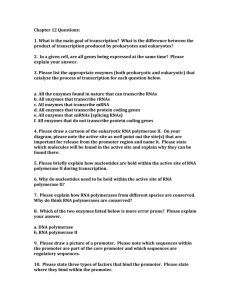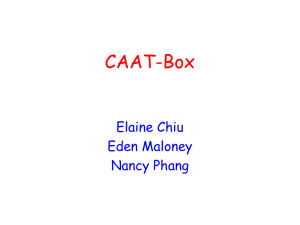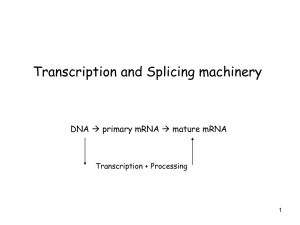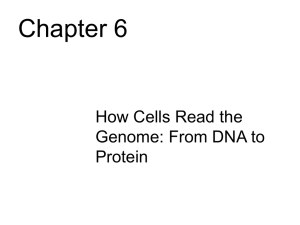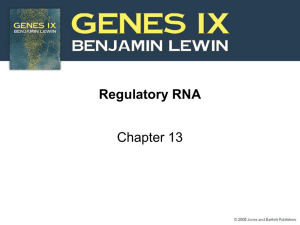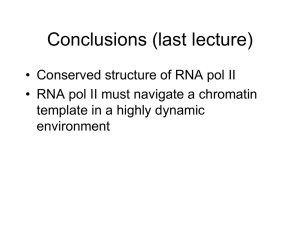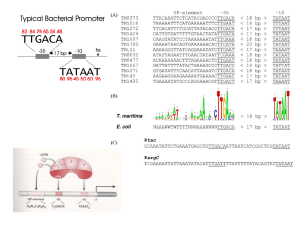Chapter 12: Mechanisms of Transcription I. Introduction A
advertisement
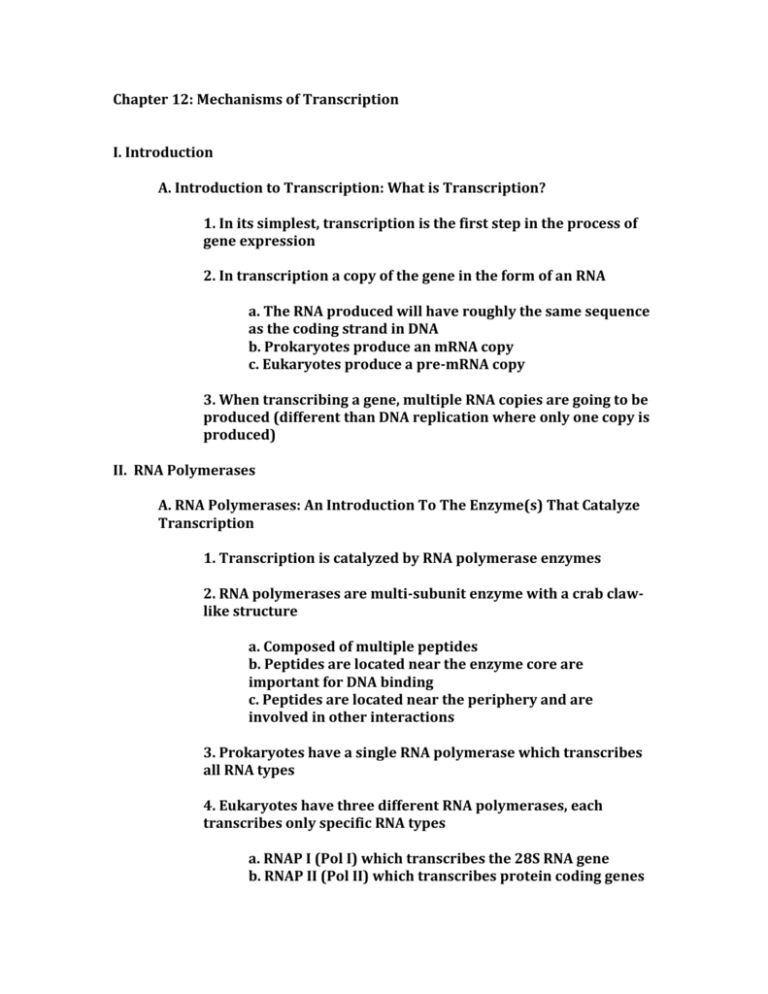
Chapter 12: Mechanisms of Transcription I. Introduction A. Introduction to Transcription: What is Transcription? 1. In its simplest, transcription is the first step in the process of gene expression 2. In transcription a copy of the gene in the form of an RNA a. The RNA produced will have roughly the same sequence as the coding strand in DNA b. Prokaryotes produce an mRNA copy c. Eukaryotes produce a pre-mRNA copy 3. When transcribing a gene, multiple RNA copies are going to be produced (different than DNA replication where only one copy is produced) II. RNA Polymerases A. RNA Polymerases: An Introduction To The Enzyme(s) That Catalyze Transcription 1. Transcription is catalyzed by RNA polymerase enzymes 2. RNA polymerases are multi-subunit enzyme with a crab clawlike structure a. Composed of multiple peptides b. Peptides are located near the enzyme core are important for DNA binding c. Peptides are located near the periphery and are involved in other interactions 3. Prokaryotes have a single RNA polymerase which transcribes all RNA types 4. Eukaryotes have three different RNA polymerases, each transcribes only specific RNA types a. RNAP I (Pol I) which transcribes the 28S RNA gene b. RNAP II (Pol II) which transcribes protein coding genes c. RNAP III (PolIII) which transcribes tRNA, snRNA, snoRNA genes as well as the 5S rRNA 5. The bacterial RNA polymerase most resembles RNA polymerase II from eukaryotes structurally B. RNA Polymerases: The Structure of The Enzyme That Catalyzes Transcription 1. Each RNA polymerase contains several common characteristic features of enzymes a. Active site b. Regulatory sites on outer binding surfaces 2. The pincers of the crab-claw structure are composed of the largest subunits a. Β and β’ for prokaryotes b. RBP1 and RBP2 for eukaryotes C. RNA Polymerases: The Structure of The Enzyme That Catalyzes Transcription 1. The crab-claw structure allows the enzyme to incorporate the following into the active site of the enzyme a. DNA template (substrate) b. Ribonucleotides c. The RNA that is being produced (product) 2. The active site works via the two metal ion-catalytic mechanism for nucleotide addition a. The active site contains one Mg2+ b. The other Mg2+ is brought in with each new nucleotide to be added 3. Mg2+ ions stabilize the nucleotide to be added in the active site for a short period of time a. Allows the condensation reaction to occur long enough for condensation reaction to occur b. A phospho-diester bond to form D. RNA Polymerases: Introduction To Mechanism of Action 1. Functional characteristics of RNA polymerases a. Produce many copies b. Can be somewhat error prone (more than DNA polymerases) 2. RNA polymerases are still fairly accurate a. One mistake per every 10,000 nucleotides b. DNA polymerases are even more accurate at one mistake per every 10,000,000 bases) 3. When RNA polymerase synthesizes an RNA it does not remain base paired to the template DNA strand a. RNA polymerase displaces the growing RNA chain 3-5 nucleotides (5’) to the newly added ribonucleotide b. Increases transcriptional efficiency by allowing RNA polymerases to follow one another III. Promoter Structure A. The Structure Of A Promoter: The RNA Polymerase II Core Promoters 1. The eukaryotic promoter for protein coding genes lies between the -100 bp - +35 bp a. Core Promoter b. Regulatory sequences 2. The Core Promoter: a. Generally 40-60 nucleotides long and extends upstream and downstream from the transcription start site b. Minimal amount of promoter sequence to initiate transcription 3. The following elements are located in Pol II promoters and are bound by specific proteins a. BRE (TFIIB recognition element) b. TATA Box c. Initiator (Inr) d. Downstream promoter elements known as the DPE, DCE and MTE) B. The Structure Of A Promoter: The RNA Polymerase II Core Promoters 1. Core promoters have some, but not all of the elements 2. Core promoters can have a. DPE with the consensus sequence GGGCGCCC or CCACGCCC (less common) b. TATA Box (more common) in conjunction with a DCE (Downstream Core Element) c. Will not have both 3. Initiator (Inr) elements are generally found in all eukaryotic core promoters C. The Structure Of A Promoter: Promoter Regulatory Elements 1. Regulatory elements are located upstream of the core promoter and bind proteins that regulate transcription a. Found between -100 bp and -35 bp b. Promoting efficient transcription c. Repression of transcription 2. Three different regulatory elements that promote efficient transcription are as follows: a. Promoter proximal elements b. Upstream activator sequences (UAS) c. Enhancers 3. Three different regulatory elements that act to repress transcription are as follows: a. Silencers b. Boundary elements c. Insulators IV. Building a Transcription Pre-Initiation Complex A. Building A Transcription Pre-Initiation Complex: Introduction 1. Proteins that bind core promoter elements are general transcription factors 2. General Transcription factors are involved in initiating transcription of most protein coding genes 3. General transcription factors play three significant roles in initiating transcription a. Help RNA polymerase II to bind the promoter b. Melt the DNA c. Help the RNA polymerase II to escape the promoter and elongate the transcript 4. Transcription is mediate by forming the pre-initiation complex on the core promoter a. Complete set of general transcription factors plus b. Recruited RNA polymerase II B. Building A Transcription Pre-Initiation Complex: The Binding Of The General Transcription Factors 1. Formation of the pre-initiation complex occurs on the TATA box a. Located about 30 bp upstream of the transcriptional start site b. Bound by the general transcription factor TFIID 2. TFIID is critical for Pre-initiation complex assembly, without it the pre-initiation complex fails to form 3. TFIID is a multi-subunit protein a. TBP subunit which binds the TATA box b. TAFs (TBP Associated Factors)-some of which may recognize other core promoter elements 4. Building A Transcription Pre-Initiation Complex: The Binding Of The General Transcription Factors a. TBP recognize the minor groove of the TATA element b. Unexpected-most sequence specific binding proteins recognize the major groove c. Minor groove recognition is necessary for DNA distortion 5. TBP subunit DNA binding causes the minor groove to widen and flatten 6. TFIID provides a platform for other general transcription factors and in the end the RNA polymerase II to bind C. Building A Transcription Pre-Initiation Complex: The Binding Of The General Transcription Factors 1. The rest of the general transcription factors and RNA polymerase II are recruited in the following order a. TFIIA b. TFIIB c. TFIIF and RNA polymerase (II)-stabilizes pre-initiation complex d. TFIIE e. TFIIH 2. Once all of these components are bound, the promoter is melted a. Melting is carried out by the helicase TFIIH b. Requires the use of ATP D. Building a Pre-Initiation Complex: RNA Polymerase Escape From The Promoter 1. Promoter escape must occur for RNA polymerase II to start transcribing a pre- mRNA 2. Promoter escape by RNA polymerase II involves two steps a. ATP hydrolysis b. Phosphorylation of the RNA polymerase 3. The largest subunit of RNA Polymerase II enzyme has a long carboxy terminal domain (referred to as CTD) a. CTD contains multiple copies of a heptapeptide sequence (NH2-Tyr-Ser-Pro-Thr-Ser-Pro-Ser) b. Yeast has 27 c. C. elegans has 32 d. Drosophila has 45 e. Humans have 52 E. Building a Pre-Initiation Complex: RNA Polymerase Escape From The Promoter 1. Within the heptapeptide sequence, the threonines and serines can be phosphorylated by a number of enzymes 2. Phosphorylation results in the RNA polymerase II enzyme: a. Becomes unbound from the most of the general transcription factors b. Leaves the promoter and starts the elongation phase of transcription V. Transcriptional Elongation A. Transcriptional Elongation: Other Proteins Are Necessary For Efficient Elongation 1. Elongation results in RNA Polymerase II enzyme transcribing a pre-mRNA a. RNA polymerase II elongate the new pre-mRNA in the 5’ 3’ direction b. RNA polymerase II moves along the non-coding strand in the 3’ 5’ direction 2. In the elongation phase two set of proteins are recruited to the RNA polymerase II a. Proteins that allow for stimulation of elongation b. Proteins required for RNA processing 3. The following proteins recruited to the RNA Polymerase II enzyme for efficient elongation are as follows a. TFIIS b. hSPT5 c. pTEFb d. TAT-SF1 e. ELL 4. pTEFb is a kinase that can stimulate elongation in three ways a. Phosphorylates the serine in the second position of the heptapeptide repeat which allows for elongation to occur b. Activates another elongation factor hSPT5 c. Recruits TAT-SF1 B. Transcriptional Elongation: Other Proteins Are Necessary For Efficient Elongation 1. RNA Polymerase II does not perform elongation at a constant rate a. Certain template sequences result in slowing of elongation rate b. Certain template sequences result in pausing 2. Both ELL and TFIIS promote efficient elongation by limiting the pauses a. ELL acts to suppress transient pausing b. TFIIS acts to reduce the amount of time an RNA polymerase is paused on the template C. Transcriptional Elongation: Modulating Chromatin Structure Via FACT Complex 1. Supplemental Figure: Transcriptional Elongation: Modulating Chromatin Structure Via FACT Complex 2. Most DNA is packaged such that it is wound into chromatin a. DNA is associated with nucleosomal components b. DNA winding inhibits progression of the RNA polymerase II (and associated factors) during transcription 3. FACT complex (Facilitates Chromatin Transcription) is a heterodimer a. Heterodimer composed of Spt16 and SSRP1 b. Modulates chromatin structure to allow for progression of RNA polymerase II 4. Each FACT subunit will bind to a component of the core nucleosome a. Spt16 binds to the H2A/H2B heterodimers b. SSRP1 binds the H3/H4 tetramer 5. FACT modulates chromatin structure by dismantling nucleosomes in the path of the elongating RNA Polymerase II enzyme a. Dismantles nucleosomes by removing one H2A/H2B heterodimer b. Reassembles nucleosomes by re-incorporating the H2A/H2B heterodimer once RNA polymerase II has passed VI. Pre-mRNA Processing A. Pre-mRNA Processing: The RNA Polymerase II Enzyme Recruits PremRNA Processing Enzymes 1. Pre-mRNA processing occurs co-transcriptionally 2. The RNA Polymerase II CTD binds proteins involved in pre -mRNA processing 3. The three processes involved in pre-mRNA processing are as follows: a. pre-mRNA Splicing b. 5’ Cap addition c. 3’ Poly(A) tail addition 4. pre-mRNA splicing is a more complex process than the other two and is coupled to transcription a. Involves a whole host of proteins b. UsnRNAs 5. Some of the splicing machinery is also recruited to the RNA polymerase II CTD by TAT-SF1 B. Pre-mRNA processing: 5’ Cap Addition 1. The first pre-mRNA processing step that occurs is 5’ capping 2. The 5’ capping occurs as soon as the 5’ end of the pre-mRNA exists the Pol II active site 3. The type of cap the 5’ capping to be added to the pre-mRNA is a 5’-methyl guanosine cap 4. The 5’ methyl guanosine cap is added by series of three enzymes a. RNA triphosphatase b. RNA guanylyltransferase (transfers GMP from GTP to the diphosphate end of the RNA to form The Gppn-Cap c. RNA guanine-7-methyl transferase (adds a methyl group 5. All three enzymes are considered the “capping enzyme” and are recruited to the pre-mRNA as well as having their activities stimulated by hSPT5 6. The first step in cap addition is removal of a phosphate group from the 5’ end of the RNA by the RNA triphosphatase enzyme 7. The second step is addition of the GMP moiety to the βphosphate of the first nucleotide by the RNA guanylyl transferase enzyme 8. The third step is the addition of a methyl group to the nitrogen at position 7 in the guanine ring structure C. Pre-mRNA Processing: Poly(A) Tail Addition 1. The signal for poly(A) tail addition is located at the end of a gene a. Carries the AATAAA sequence, which when transcribed is AAUAAA b. Considered the poly(A) signal sequence 2. Poly(A) tail addition is linked to the termination of transcription and is carried out by two proteins a. CPSF (cleavage and polyadenylation specificity factor) b. CstF (Cleavage stimulation factor) 3. Both the CPSF and CstF proteins are recruited and carried by the RNA polymerase II CTD as it approaches the end of a gene (AAUAAA) sequence 4. Once the poly-adenylation signal sequence is (AAUAAA) is transcribed: a. Triggers the transfer of the CPSF and CstF proteins to the pre-mRNA b. CPSF/CstF cleaves the pre-mRNA at the polyadenylation signal sequence 5. Polyadenylation is initiated at the point of cleavage a. Mediated by poly(A) polymerase (PAP) b. PAP adds adenosines to create the poly(A) tail using ATP as a precursor c. PAP can add a few adenosines to up to thousands of adenosines 6. Cleavage and polyadenylation completion a. Final steps temporally in pre-mRNA b. Once complete, the mRNA is mature and can be exported to the cytoplasm 7. Note: although the mRNA is mature, this does not trigger the RNA pol II enzyme to fall off the template DNA, it keeps on transcribing! VII. Regulation of Transcription A. Regulation of Transcription: Introduction 1. The process of controlling which genes are being expressed is considered “Regulation of Gene Expression” a. Regulation of gene expression necessary for development as well as normal cell function b. Not all genes will be expressed in all cells all of the time 2. One way to regulate gene expression is to regulate transcription a. If an mRNA is produced, then the gene is expressed (which can be then translated to produce protein) b. If an mRNA is not produced, then the gene is not expressed B. Regulation of Transcription: The Promoter and Regulatory Transcription Factors 1. Regulation of transcription occurs at the regulatory regions of the promoter a. Upstream of the core promoter (between -35 and -100 bp) b. Regulatory sequences act to control gene expression by binding regulatory transcription factors 2. There are two types of regulatory transcription factors a. Activating transcription factors b. Inhibitory transcription factors C. Regulation of Transcription: The Promoter and Regulatory Transcription Factors 1. Regulatory transcription factors control transcription in one of two ways a. Recruit or block efficient RNA polymerase II binding to the core promoter b. Effect the winding of the DNA 2. Descriptions of regulatory transcription factors that either block, or efficiently recruit RNA polymerase to the promoter a. Activating transcription factors recruit and “activate” RNA polymerase II through mediator b. Inhibitory transcription factors often block RNA polymerase II binding to the promoter 3. Descriptions for those regulatory transcription factors that effect winding of the DNA a. Activating transcription factor will promote looser winding of the DNA b. Inhibitory transcription factors will cause the DNA to wind more tightly D. Regulation of Transcription: Promoter Mutations Congenital Erythropoietic Porphyria 1. Mutations that affect transcription can lead to severe disease a. Generally promoter mutations b. Generally not mutations that affect the general transcription factors 2. Very few diseases are caused by mutations in the regulatory promoter region 3. Congenital erythrpoietic porphyria: a. Known as Gunther’s disease, and is very rare b. Autosomal recessive disease c. Caused by a mutation in the regulatory promoter uroporphyrinogen-I synthease (URO-I) gene 4. The URO-1 gene encodes the uroporphyrinogen-I synthease enzyme a. Mainly expressed in the erythrocytes, teeth, bones and skin b. Important enzyme in the pathway for synthesizing heme in red blood cells 5. CEP can be debilitating and has several symptoms a. Skin photosensitivity leading to blistering b. Severe scarring c. Increased hair growth d. Facial features may be damaged due to photosensitivity e. Increased risk of bacterial infection also due to photosensitivity f. Can be some anemia 6. Severe cases of CEP can have onset during childhood 7. Weaker cases of CEP can have adult onset 8. The pathology of this disease is still poorly understood 9. This disease can be caused by a G A transition in the promoter region (nt -76) 10. This transition disrupts the binding of the activating transcription factor GATA1 11. With respect to the URO-I gene, then there are three different possible genotypes (U = wild-type allele; u = mutant allele) a. UU b. Uu c. Uu 12. In the case of the UU individual, the individual has two wildtype alleles and makes the normal amount of URO-1 enzyme (100%) 13. In the case of the Uu individual, the individual has one wildtype, and one mutant allele a. URO-1 transcription from the wild-type copy is normal b. URO-1 transcription from the mutant allele is greatly reduced (~0% of the wild-type) c. This person ends up making about 50-58% of the URO-1 enzyme of the UU individual, but is phenoytpically normal 14. The CEP patient has a genotype of uu a. This patient has two mutant alleles, b. Each allele, transcription is reduced to 0-8% of normal c. This patient produces about 0- 16% of the URO-1 enzyme compared to the UU individual E. Regulation of Transcription: p53 and Cancer 1. Mutations that lead to changes in amino acid sequence of regulatory transcription factors can lead to disease, especially cancer 2. The p53 gene a. Probably the most important gene with respect to the study of cancer b. Knock-out mice have no developmental phenotype c. Knock-out mice develop cancer early in life 3. The p53 gene is a tumor suppressor gene that encodes a regulatory transcription factor 4. The levels of p53 protein are not always high in the cell a. Under normal conditions (no DNA damage), p53 protein levels are low b. Under conditions where there is DNA damage, p53 protein levels are increased 5. p53 activates transcription of two classes of target genes a. Genes that act to halt the cell cycle (p21) b. Genes that promote apoptosis (DR4, DR5, BAX) 6. p53 in response to DNA damage, activates transcription of p21 a. The role of p21 is to complex with cdk2 b. The p21/cdk2 heterodimer acts to stop cell cycle progression 7. Under severe DNA damage a. p53 activates Mdm2, b. Leads to apoptosis 8. In cancers, mutations in p53 actually result from DNA damage 9. Mutations in the p53 gene allow for changes in amino acid sequence of the p53 protein a. Result in its inability to bind regulatory promoter sequences b. Activation of transcription of target genes will not occur 10. Those individuals that are born with just one mutant copy of the p53 gene have Li-Fraumeni Syndrome 11. Li-Fraumeni syndrome: a. Shows autosomal dominant inheritance b. Rare-only 400 families in the US show this disorder 12. Cancers commonly found in Li-Fraumeni patients a. Osteosarcomas b. Brain Tumors c. Schwannoma d. Leomyosarcoma –Breast Cancers –adrenocarcinomas
